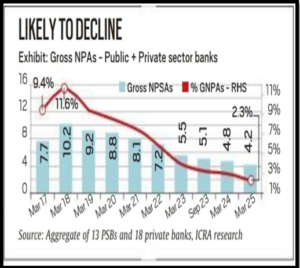IMPROVEMENT IN BANK NPAS
Why in the News?
- Reserve Bank of India (RBI) data reveals a decline in scheduled commercial banks’ (SCBs) Gross Non-Performing Assets (GNPAs) from 3.9% at end-March to 3.2% at end-September.
- The agricultural sector maintains the highest GNPA ratio, while retail loans exhibit the lowest at end-September.
The Data :
- The industrial sector sees enhanced asset quality, with its GNPA ratio reaching 4.2% at end-September 2023.
- Notably, large industries show a significant reduction in GNPA ratio from 22.9% at end-March 2018 to 4.6% at end-June 2023.
Source: The Hindu
About NPA :
- NPA categorizes loans or advances in default, indicating failure in scheduled payments of principal or interest.
- Typically, debt qualifies as non-performing when payments remain overdue for a minimum of 90 days.
- In agriculture, NPA status is assigned if both principal and interest remain unpaid for two consecutive cropping seasons.
- Banks are required to classify NPAs further into Substandard, Doubtful and Loss assets.
- Substandard assets: Assets which has remained NPA for a period less than or equal to 12 months.
- Doubtful assets: An asset would be classified as doubtful if it has remained in the substandard category for a period of 12 months.
- Loss assets: As per RBI, loss asset is considered uncollectible and of such little value that its continuance as a bankable asset is not warranted, although there may be some salvage or recovery value.
- Types of NPAs:
- Gross NPA: Represents the total value of defaulted loans by individuals.
- Net NPA: Signifies the amount realized after deducting the provision amount from the total gross non-performing assets.

 Source: The Hindu
Source: The Hindu

